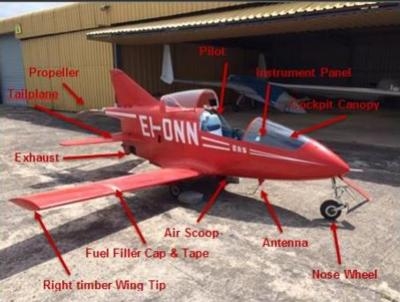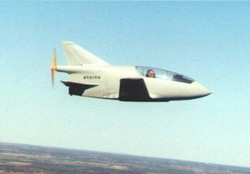CAA Cited Type's Poor Safety Record
Ireland's Air Accident Investigation Unit has released a report from an accident which occurred July 25 that fatally injured Howard Cox, the pilot of the aircraft.

Cox, 67, had over 3,200 hours of flying time at the time of the accident. He was traveling to an air show in west Ireland when the engine of the single-place aircraft failed and he attempted an emergency landing. The plane impacted terrain and caught fire.
According to the report, Cox had built the aircraft from a kit. He had originally used a Honda auto engine to provide power. This engine installation was considered to be very heavy, not as reliable as anticipated and there were no definitive installation diagrams provided.
He received a permit to fly in September 1994. On 14 December 1994, while carrying out a go-around at Chivenor Airfield, Devon, UK, the aircraft suffered an engine stoppage at approximately 100 ft. The aircraft made a wheels-up landing on a grass strip.
The engine was replaced with a Mid-West GIAE 110 R, twin rotor, water cooled, rotary (Wankel10) engine. It was fitted with four fuel pumps; two were pressure pumps for engine fuel supply and two were transfer pumps for moving fuel between the wing tanks in-flight to ensure that the aircraft remained balanced.
Notes compiled by a pilot who had flown the accident aircraft record that the reason for two of each pump was redundancy; only one pressure/transfer pump was used at any time, and the engine was shut down by switching off the fuel pumps using the switches located on the left hand side console.
The report indicates that on September 27, 1999, the CAA wrote to the Cox advising him that in light of his stated intention (earlier that year) to apply again for a Permit-to-Fly for the aircraft, the CAA had reviewed the basis on which the approval was to be granted. The result of that review was that the CAA was not prepared to proceed toward the issue of a Permit-to-Fly for an aeroplane which had essentially the same flight characteristics as the BD-5 aircraft which had flown previously in the U.S..

The CAA cited statistics obtained from the Federal Aviation Administration (FAA) and National Transportation Safety Board (NTSB) which gave the total number of BD-5 incidents/accidents (1972-1998) as 81 with 22 fatalities and 15 serious injuries. The CAA also indicated its belief that many incidents involving aircraft in the BD-5 category go unreported and it concluded that the true incident/accident totals may be significantly higher. The CAA noted that between 5,000 and 6,000 BD-5 aircraft kits were sold but that many of these lacked significant parts, particularly relating to the engine installation and therefore only a
small percentage of these kits were completed as flying aircraft. The CAA estimated the number of completed aircraft to be in the low hundreds.
In 2006, the airplane was approved for operation in Ireland by the Irish Aviation Authority.
About eight minutes into his flight, Cox informed ATC that he had an engine fire and declared an emergency, and that he had lost elevator authority in the airplane.
The AAIU concluded that the aircraft was subject to a tail wind component as it approached the selected field. The left wing of the aircraft impacted a tree in the boundary hedgerow and separated from the aircraft.
There were five distinct fire events: the in-flight fire in the engine compartment; the deflagration when the left wing separated and its fuel tank ruptured; the third and fourth fire events occurred as the aircraft approached the field boundary and involved fuel from the left hand wing tank scorching the foliage. The fifth fire event occurred when the aircraft came to rest, inverted, and a fuel-fed ground fire took hold.
The Investigation believes that the more likely scenario was the ignition of fuel released within the engine compartment, and that the accident was not survivable.
(Top image included in accident report annotated by the AAIU. Lower image from file)
 ANN's Daily Aero-Term (04.26.24): DETRESFA (Distress Phrase)
ANN's Daily Aero-Term (04.26.24): DETRESFA (Distress Phrase) ANN's Daily Aero-Linx (04.26.24)
ANN's Daily Aero-Linx (04.26.24) Airborne 04.22.24: Rotor X Worsens, Airport Fees 4 FNB?, USMC Drone Pilot
Airborne 04.22.24: Rotor X Worsens, Airport Fees 4 FNB?, USMC Drone Pilot Airborne 04.24.24: INTEGRAL E, Elixir USA, M700 RVSM
Airborne 04.24.24: INTEGRAL E, Elixir USA, M700 RVSM Airborne-NextGen 04.23.24: UAVOS UVH 170, magni650 Engine, World eVTOL Directory
Airborne-NextGen 04.23.24: UAVOS UVH 170, magni650 Engine, World eVTOL Directory




